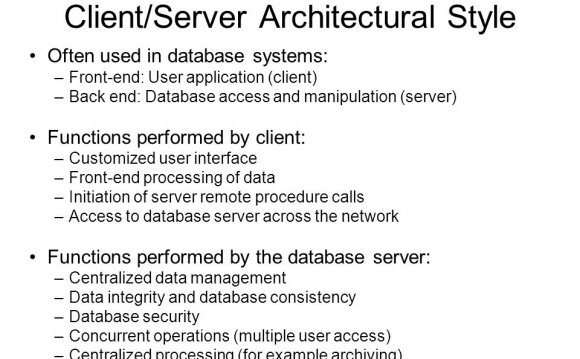
Prior to the popularity of the web, client/server applications often involved the creation of native applications which were deployed to clients. In this model, developers had a great deal of freedom in determining which parts of the entire client/server application would be in the client and which in the server. Consequently, very mature models for client/server development emerged, and often well designed optimal distribution of processing and logic could be achieved. When the web took off, the client was no longer a viable application platform, it was really more of a document viewer. Consequently the user interface logic existed almost entirely on the server. However, the web has matured substantially and has proven itself to be a reasonable application platform. We can once again start utilizing more efficient and well-structured client/server model design. There are certainly still technical issues, but we are in a position to better to build true client/server applications now.
- User Interface
- Business or Application Logic
- Data Management
- Poor distribution of processing – With a large number of clients, doing all the processing on the server is inefficient.
- High user response latency – Traditional web applications are not responsive enough. High quality user interaction is very sensitive to latency, and very fast response is essential.
- Difficult programming model – Programming a user interface across client/server is simply difficult. When every interaction with a user must involves a request/response, user interface design with this model is complicated and error prone. The vast number of web frameworks for simplifying web development testifies to this inherent difficulty. Some have mitigated this difficulty to some degree.
- Increased vector of attack – Unorganized mingling of user interface code with business code can increase security risks. If access rules are distributed across user interface code, as user interface code grows and evolves, new vectors of attack emerge. With mixed code, new user interface features can easily create new security holes.
- Heavy state management on the servers – When client user interface state information is maintained by the server, this requires a significant increase in resource utilization as server side sessions must be maintained with potentially large object structures within them. Usually these resources can’t be released until a session times out, which is often 30 minutes after a user actually leaves the web site. This can reduce performance and scalability.
- Offline Difficulties – Adding offline capabilities to a web application can be a tremendous project when user interface code is predominantly on the server. The user interface code must be ported to run on the client in offline situations.
- Reduced opportunity for interoperability – When client/server communication is composed of transferring internal parts of the user interface to the browser, it can be very difficult to understand this communication and utilize it for other applications.
With the massive move of development to the web, developers have frequently complained of the idiosyncrasies of different browsers and demanded more standards compliance. However, the new major shift in development is towards interconnectivity of different services and mashups. We will once again feel the pain of programming against differing APIs. However, we won’t have browser vendors to point our fingers at. This will be the fault of web developers for creating web applications with proprietary communication techniques.
Much of the Ajax movement has been related to the move of user interface code to the client. The maturing of the browser platform and the availability of HTTP client capabilities in the XMLHttpRequest object, have allowed much more comprehensive client side user interface implementations. However, with these new found capabilities, it is important to understand how to build client/server applications.
So how do you decide what code should run on the client and what should the run on the server? I have mentioned the problems with user interface code running on the server. Conversely, running business logic and/or data management on the client is simply not acceptable for security reasons. Therefore, quite simply, user interface code is best run on the browser, and application/business logic and data management is best run on the server side. We can take a valuable lesson from object oriented programming to guide this model. Good OO design involves creating objects that encapsulate most of their behavior and have a minimal surface area. It should be intuitive and easy to interact with a well designed object interface. Likewise, client and server interaction should be built on a well-designed interface. Designing for a modular reusable remote interface is often called service oriented architecture (SOA); data is communicated with a defined API, rather than incoherent chunks of user interface. A high quality client/server implementation should have a simple interface between the client and server. The client side user interface should encapsulate as much of the presentation and user interaction code as possible, and the server side code should encapsulate the security, behavior rules, and data interaction. Web applications should be a cleanly divided into two basic elements, the user interface and the web service, with a strong emphasis on minimal surface area between them.









